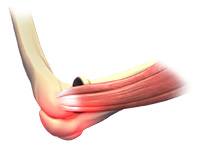Elbow Sprain

An elbow sprain is an injury to the soft tissues of the elbow. It is caused due to stretching or tearing (partial or full) of the ligaments that support the elbow joint. Ligaments are a group of fibrous tissues that connect one bone to another in the body.
The elbow is a complex hinge joint formed by the articulation of three bones - humerus, radius and ulna. The upper arm bone or humerus connects the shoulder to the elbow to form the upper portion of the hinge joint. The lower arm consists of two bones, the radius and ulna. These bones connect the wrist to the elbow to form the lower portion of the hinge joint. A joint capsule surrounds the elbow joint, which contains lubricating fluid called synovial fluid.
Causes
The various causes of an elbow sprain are
- Involuntary twisting of the arm during sports activities
- Traumatic injury to the elbow due to an accident or fall
- Overstretching of the elbow during exercise, thus increasing the tension on the elbow tendons
- Lack of warming up and stretching prior to performing exercises or sports activities
- Medical history of previous elbow sprains, making you more vulnerable to another sprain
Symptoms
The common symptoms of an elbow sprain include:
- Pain, swelling, tenderness and bruising around the elbow
- Restricted movement of the elbow
- Pain at the elbow joint while stretching
Elbow sprains are graded depending upon the severity of the symptoms as grade I (mild), grade II (moderate) and grade III (severe). Severe elbow sprains of grade III can lead to elbow dislocation or joint instability.
Diagnosis
Your doctor will take a detailed medical history and perform a thorough physical examination. An X-ray of the elbow may be necessary to rule out any fractures or other disease conditions. Rarely, an MRI may be ordered.
Treatment
The treatment for an elbow sprain is as follows:
- Rest: Avoid using the affected elbow for a few weeks. Restrict all activities that cause overuse of the elbow.
- Ice packs: Apply ice bags wrapped in a towel over the sprained elbow for 15-20 minutes at a time to help alleviate any possible pain and swelling.
- Compression: An elastic compression bandage is used to wrap and support the elbow to reduce swelling. Take care not to wrap too tightly so as to constrict blood vessels.
- Elevation: Keep your sprained elbow elevated as much as possible. This can be done by placing pillows under your arm.
- Immobilisation: A sling or splint may be applied to stabilise the elbow joint.
- Medications: You will be prescribed pain medications to keep you comfortable, and antibiotics to prevent infection.
- Physiotherapy: Learn appropriate hand exercises to strengthen your forearm muscles. Various modalities of physiotherapy, such as massage, ultrasound and muscle stimulation, may also be performed to improve muscle strength.
- Surgery: Generally, elbow sprains do not require surgery. It is indicated only in cases of severe damage or tear of the ligament.
Prevention
You can prevent elbow sprains by following the below:
- Exercise on a regular basis to improve muscle strength.
- Eat a healthy diet that includes a variety of nutritious foods.
- Use well-checked equipment for any sports activities.
- Always warm-up and stretch your muscles prior to performing exercises or sports activities.













